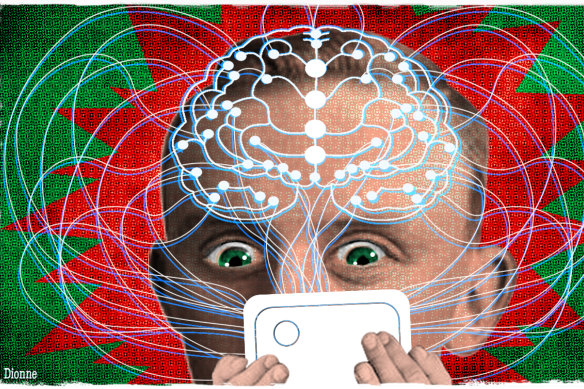
Your brain might be your greatest asset – and your most private. But soon, your brain’s data could be at the centre of a new wave of intellectual interference and disinformation – one that could exceed the fears around generative AI.
Though neurotechnology, which can read and even influence the brain’s patterns and electrical activity, has existed for some time in the medical context of monitoring neurological conditions, consumer devices will soon hit the mainstream. Apple’s Vision Pro, which offers rudimentary neurotechnology through iris-tracking cameras will be released on February 2, while Meta’s neural smart watch is expected in early 2025.

Illustration: Dionne Gain
Recent advances in neuroscience and AI are paving the way for improved consumer applications. These include complex and invasive BCIs – brain-computer interfaces – like Elon Musk’s Neuralink, which has just announced a successful brain implant, which could, for example, let a paralysed person type, or play video games.
This new era of consumer neurotechnology will herald unprecedented disinformation, influence and interference.
As the last piece in the jigsaw puzzle of data collection, neurotechnology and the brain data it collects offers those who own and access this information insight into an individual’s thoughts and emotions. It goes beyond the likes, swipes and clicks to capture unconscious reactions, individual bias, feelings, preferences and emotional states.
Disinformation will be supercharged by the introduction of neurotechnology. Generative AI – algorithms such as ChatGPT that draw on vast training data to generate streams of “new” content using prompts – can rapidly create and distribute disinformation tailored to the individual. However, neurotechnology and AI will build on the vast data already in existence to customise and adjust content to cater to each individual’s specific feelings and current emotional state – offering the ability to create a feedback loop fuelled by brain data. A simple example would be where, while scrolling through your news feed, you have a positive emotional response to reading a statement of hate speech. A social media platform could then set its algorithm to feed your brain more of the same content to elicit the positive response again.
As Duke University law professor Nita Farahany explains, the commercialisation of this technology poses serious risks. “You have the same tech company that has access to ... brain data that’s [also] driving the environment that the person is operating in, like an immersive or spatial computing environment, where it almost becomes like people are in a matrix that is operated by a foreign adversary.”
Loading
Until a now, much of the policy conversations around addressing these dangers have focused on areas such as content moderation, and dealing directly with the platforms that enable the dissemination of generative AI-produced disinformation. However, with the introduction of neurotechnology, it is the cognitive liberty and resilience of individuals that can be manipulated through changes in algorithms that respond to inputs from brain data.



























